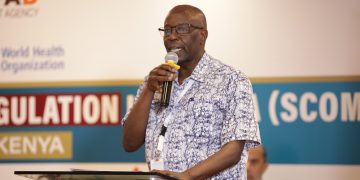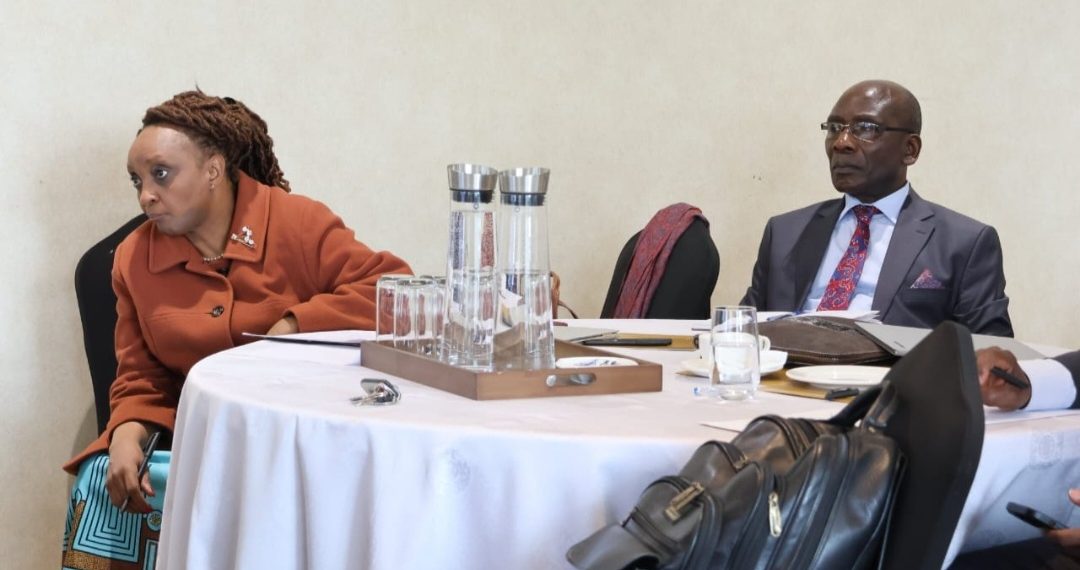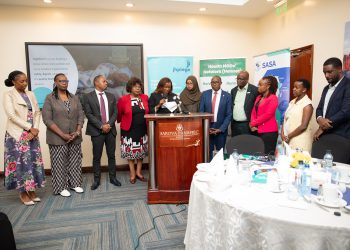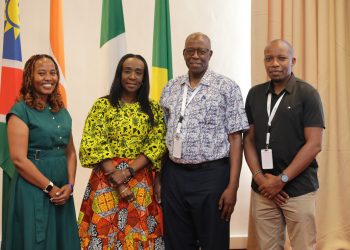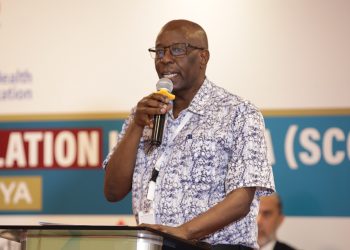In October thousands of runners lined up across Kenya and five other African Countries for the 2025 “Run for Her” campaign, What began as a community advocacy project to raise awareness on postpartum haemorrhage (PPH) has been twinned into one of the most ambitious maternal-health interventions in East Africa ‘the Roaming Blood Bank.’
Professor Moses Obimbo, University of Nairobi Proffesor and the project lead for the National Project on End Postpartum Haemorrhage (EPPH) says that the initiative, founded in 2024, is anchored on four pillars: advocacy and community engagement, research, training of health workers, and strengthening data systems. But as Prof. Obimbo recalls, one issue repeatedly surfaced as the most urgent the lack of blood for mothers who bleed after childbirth.
“Out of every 10 women who died from postpartum bleeding, four died simply because there was no blood for transfusion,” he explains adding that “We could not sit back and watch.”
In September 2025, days before the annual Run for Her, the EPH team launched a bold concept, the Roaming Blood Bank.
According to Prof Obimbo unlike traditional donation drives that wait for volunteers, this model goes directly into communities, campuses, markets and public spaces.
Between 22 September and 2 October, mobile teams spread across Nairobi from Eastlands to the University of Nairobi medical school to Kenya Medical Training College (KMTC) in just 10 days, the drive collected 875 units of blood, a record for a short-term campaign in the country.
“This is blood that will save mothers from dying,” Prof. Obimbo says. “It’s the largest amount of blood we have ever collected in Kenya within such a short window.”
He says that the volume was not just a statistic it represented hundreds of potential lives saved in maternity wards where delays in securing blood often turn preventable complications into tragedies.
The momentum behind the blood drive mirrors the explosive growth of the Run for Her campaign itself. The inaugural run in 2024 attracted national attention, by 2025, participation had surged to over 15,000 runners across Kenya, joined by participants from five other African countries.
“It has truly become a global movement,” Prof. Obimbo says. “And more importantly, communities now know what postpartum haemorrhage is, and why fast action is critical.”
The success of the End Postpartum Haemorrhage marathon and the Roaming Blood Bank caught international attention. At the 2025 FIGO World Congress the world’s largest gathering of obstetricians and gynaecologists Prof. Obimbo delivered a keynote speech sharing Kenya’s experience in community driven blood donation and PPH advocacy.
Alongside his presentation, FIGO, WHO, and the International Confederation of Midwives launched new global PPH management guidelines, led by Kenyan obstetrician and immediate former FIGO President Prof. Anne Beatrice Kihara said that among the most significant achievement at FIGO conference was redefining PPH as blood loss exceeding 300 ml, down from the previous threshold of 500 ml.
“This means we act earlier, treat earlier, and save mothers earlier,” Prof. Kihara emphasized.
She also lauded the new PPH guideline which she says will also direct health workers to measure, not estimate, blood loss, and give midwives greater authority to initiate the PPH emergency protocol the EMOTIVE bundle at the bedside.
Kenya loses an estimated 3,000 women annually to excessive bleeding after childbirth. Across Africa, the figure exceeds 6,000. With the new global guidelines, expanded midwife autonomy, and the Roaming Blood Bank now ready for national scale-up, the EPPH team believes the tide can finally turn.
Prof. Obimbo said that, “We must ensure no woman dies because there was no blood. No family should suffer a loss that is completely preventable.”
“As the initiative prepares to expand beyond Nairobi, the vision is a Kenya and eventually an Africa where maternal death from PPH becomes Zero rather than a recurring tragedy.”
The Roaming Blood Bank collected 875 units of blood collected in ten days an indicator that the public is more than ready to run, donate, and stand behind the cause.
Prof. Julius Ogengo ,University of Nairobi’s Faculty of Health Sciences, who is championing the new model of community blood collection under the End Postpartum Haemorrhage (PPH) Initiative, run suported by the EPPH Foundation.
According to Prof Ogeng’o the project, known as the Roaming Blood Typing and Acquisition Scheme, is designed to close the massive blood gap that contributes to thousands of preventable maternal deaths each year.
He explains that it is built around a fresh, community-driven philosophy of blood donation that Prof. Ogengo believes could redefine emergency response for postpartum haemorrhage.
ROAMING BLOOD BANK A New Model Rooted in Community Networks
According to Ogeng’o ROAMING is more than a descriptive name but an acronym for Rural Outreach Mobilisation Initiative for Network Growth, capturing its core idea of taking blood collection and donor engagement directly to the communities where PPH is most common.
“PPH occurs more frequently in marginalised communities, where access to timely blood transfusion is often limited,” Prof. Ogengo explains. “Our philosophy is simple: you convince people to donate blood, you test it, you get their consent, and then you build a network from those willing to become repeat donors.”
At the heart of the scheme is an expanding database of community members who have donated, know their blood types, and have committed to being available whenever their blood group is urgently needed. These donors, Prof. Ogengo says, effectively “walk with their blood.”
“When a mother starts bleeding, we don’t just rely on static blood banks,” he adds. “We can reach out to these donors wherever they are, because we have their details, their contacts, and their consent.”
How the Roaming Blood Bank Works
The system relies on three interconnected networks Donors registered community members willing to give blood repeatedly,Hospitals Facilities treating women with PPH in urgent need of transfusion.Transporters Actors who move blood quickly from donor or storage point to a facility.
Prof Ogeng’o says that a mobile application, currently under development, will serve as the backbone of this ecosystem. Through the app, coordinators will locate donors, alert them to emergencies, and direct them to the nearest approved donation point.
To build this donor base, the project targets youth mobilized through social media, as well as churches, schools, community barazas, sporting events, and other gatherings.
“We take advantage of any opportunity to convince people that no mother should die because blood is unavailable,” Prof. Ogengo says.
Pilot Study Shows Strong Potential
Between 15 September and 2 October, the team conducted a pilot blood drive to test the feasibility of the ROAMING concept.
Prof Ogeng’o says that the initial focus was Pumwani, chosen for its proximity to large informal settlements where PPH cases are high.
He explains that although the first days yielded about 120 to 130 donors, the team quickly realized they needed to expand their reach. They set up additional collection points at the University of Nairobi, the CBD near Kenya National Archives, St. Paul’s, and even tapped into crowds attending upcoming charity runs in Mombasa, Kakamega, Homa Bay, and Eldoret.
He says that the end result was striking 875 units of safe blood collected in just 11 days a powerful indication that the model could work at scale.
Scaling Up to PPH Hotspots
Buoyed by the pilot’s success, the initiative is now preparing for a nationwide expansion. Particular attention will be given to counties with high PPH prevalence areas Prof. Ogengo refers to as “PPH hotspots.”
“Just this morning, I was informed that Narok is among the counties with very high rates of postpartum haemorrhage,” he says. “In the coming year, we plan a comprehensive, repeated blood drive focused on these high-need regions.”
The team is now seeking partners and financial support to scale up the programme, refine the mobile app, and strengthen the logistics network of hospitals and transport systems.
“Every contribution no matter how small brings us closer to ensuring that when a mother is bleeding, blood is never the reason she doesn’t survive,” Prof. Okengo emphasises.
If successful, the Roaming Blood Typing and Acquisition Scheme could become one of Kenya’s most transformative maternal health innovations in decades. By building a responsive, community-powered blood supply network, the initiative aims to ensure that mothers especially those in underserved communities have a fighting chance.
“We now know it works,” Prof. Ogengo says. “The task ahead is to grow it, sustain it, and make sure no mother dies from something we can prevent.”





